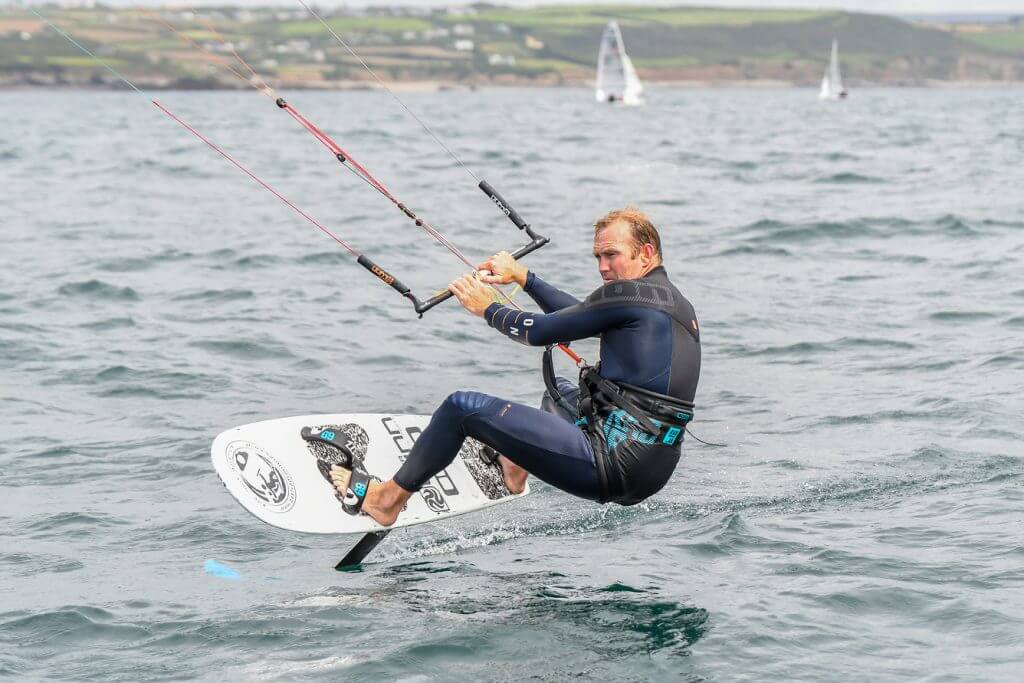Words: Lee “Pasty” Harvey
Photos: Lee Whitehead – http://www.photolounge.co.uk/
So you are up and riding on the foil.
Now it’s time to start RIPPING.
It might not seem it at the moment but the faster you ride, the more stable the foil becomes. Of course the top speed does depend on your actual foil, but generally speed is your friend especially in manoeuvres.
Kite choice
Now you are riding the foil you are probably thinking about a lightwind specific kite.
There are two options depending on your style of riding and type of foil:
- Zero or 1 Strut Inflatable
If you just want to cruise around and have a lower aspect freeride foil then go for a kite such as the North Mono. It works amazing on the foil, with the 9m giving a wind range of 8-20 knts and the 12m 7-15knts.
Advantages – Great power for size, very manoeuvrable, great relaunch, stays in the air well, light weight, awesome wave kite.
Disadvantages – Harder to foil out of manoeuvres, low top speed, not amazing upwind.
- Foil Kite
If you are riding a higher aspect race type foil then you need a foil kite to match it.
The Peter Lynn Aero is an amazing kite which is very responsive in foil kite terms. The 14m will work from 7-20knts giving great speed and angles.
Advantages – Better for foiling manoeuvres, high speed, good angles upwind and downwind, great as a light wind boosting machine on the TT from 12knts.
Disadvantages – harder relaunch, swimming in, cost.
I recommend using a max of 22m lines on inflatables and 18m on foil kites (which, when you consider the bridle, works out at about 22m), as this will give you better precision control and allow you to position the kite exactly where you want it in the window.
Ripping Upwind
To start going really fast upwind we need to get in the groove.
Key points:
- Kite Low
Keep the kite fairly low, between 20 and 40 degrees off the water. This enables us to drive the kite forward and push the power from the kite into the foil.
If the kite is too high the lift from the kite will bring the foil too high causing it to break the surface and BANG! - Driving the Foil
With the kite low, you can really lean over and push off the foil. Keep the foil just below the surface, with your hips forward and push with your front or back foot to control how far the kite flies forward in the window. The more you can push the more lift you generate off the foil and the faster you will go. - Lock in your stance
Look where you are going and keep your hips and shoulders locked in pointing upwind. Keep the bar and kite steady, as long as you don’t make any wobbles through the foil you will stay in the groove and be ripping upwind!

The more power you can hold the faster you will rip upwind.
Fault correction:
- Foil keeps breaking surface
Kite is too high, move it lower so you can lean against the kite and put more power through your legs. - Kite wants to pull you upright
Sheet out on the bar. - Kite loses power
You have pushed the kite too far forward in window. Sheet in on bar and ease off on back leg so you bear away slightly and keep the speed on.
Ripping Downwind
Now that you are way upwind it’s time to come back downwind.
As with ripping upwind, the key to going fast and in control downwind is to get in the groove.

Key points:
- The Bear Away
The hardest part is to get from upwind to downwind without gaining too much lift. Prepare by bringing the kite up towards 1 or 11 while you are still going upwind and lowering the ride height of the foil.
Dive the kite hard pulling in on bar while pushing on the front foot to bear away.
Commitment is key! - Kite Low and infront
Due to the amount of apparent wind we generate, riding downwind is actually very similar to going upwind. Keep the kite low, sheeted in and infront of you. Bear away in the gusts and head up in the lulls to control your speed.
Keep pushing hard on the front foot with you hips back slightly to stay in the groove. If you bring the kite up too high you will crash! - Heading Up
You’ve made it downwind, now it’s time to head back upwind.
Gently bring the kite up, sheeting out whilst moving your weight forward to keep the foil down. Slowly bring the kite down the edge of the window still sheeting out while pointing up and leaning over into your upwind stance.
Going downwind is all about getting the apparent wind up so that you can go as deep and fast as possible. Commit to it and don’t be scared!
Fault correction:
- Foil keeps breaking surface
Kite is too high, get it low and get the speed on. - Can’t bear away
Be more aggressive bringing the kite down and really push on your front foot. - Can’t head back up
Sheet out more and turn quicker while bringing kite down.
Reaching Across the Wind
Foiling across the wind is actually the hardest point of sail to ride as its hard to control the speed.
The reason is you cannot bear away to lose power or send the kite to the edge of the window by pushing harder. Both actions will simply increase your speed and if you bring the kite up the foil will come out and bang. There are specific reaching foils that are pretty small and crazy fast.
Thanks to my sponsors:
Ketos Foils, North Kiteboarding, ION, Peter Lynn Race Team
Pasty offers coaching and tours in West Cornwall, UK. For more head to http://www.pastyadventures.co.uk/




